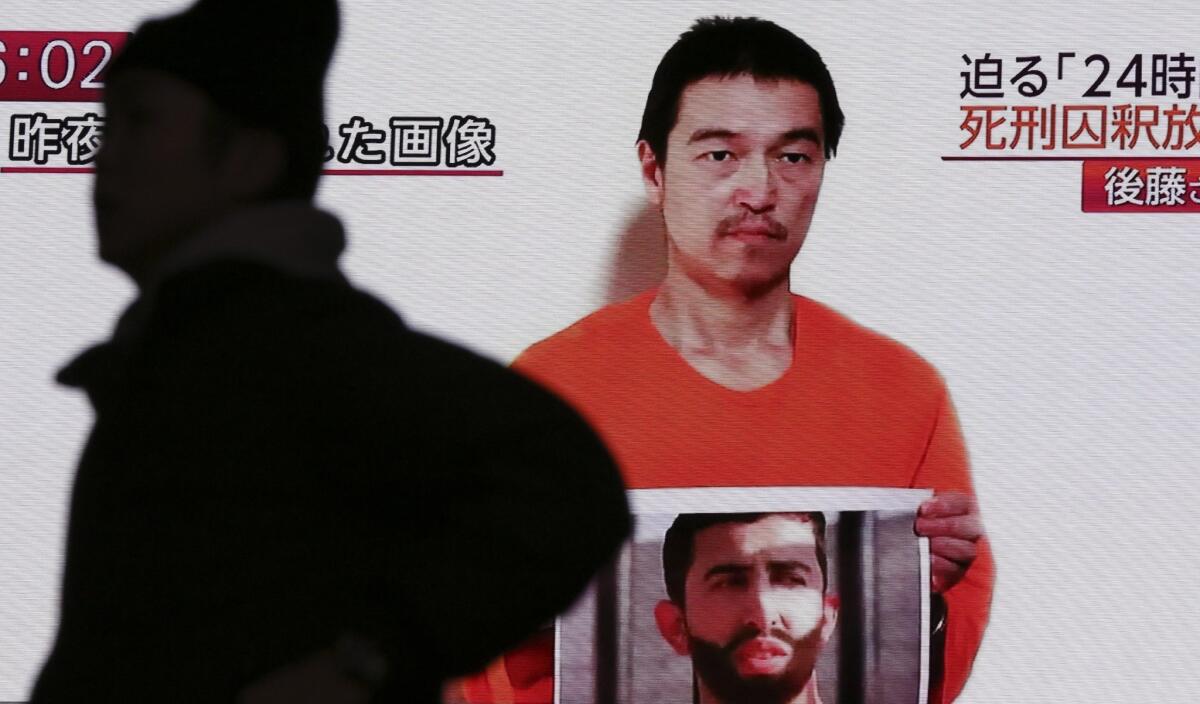Islamic State apparently beheads Japanese hostage Kenji Goto

Islamic State militants have beheaded a Japanese journalist, according to video released Saturday on the Internet, ending a wrenching drama that has gripped Japan and jolted another close U.S. ally, Jordan.
The grisly slaying of Kenji Goto, 47, an experienced war correspondent and father of two young daughters, triggered outrage across the globe and an outpouring of grief and indignation in Japan, a nation that has generally been insulated from events in the turbulent Middle East.
“We are deeply saddened by this despicable and horrendous act of terrorism, and we denounce it in the strongest terms,” a stricken Prime Minister Shinzo Abe told reporters in Tokyo about 6:40 a.m., shortly after the video appeared on the Internet. “I feel heartbreaking pain.”
Islamic State, which has been suffering battlefield reverses, has used the hostages as leverage against key U.S. partners in the Middle East and Asia.
In the graphic video confirming Goto’s slaying, the black-clad executioner declares, “So let the nightmare for Japan begin.”
In Washington, President Obama denounced the killing as a “barbaric act,” and renewed his vow to “degrade and ultimately destroy” the Sunni Islamist extremist group.
An Al Qaeda breakaway faction, Islamic State seized control of vast stretches of Syria and neighboring Iraq last year and has gleaned worldwide notoriety, and publicity, with for its ritualized beheadings, including the executions of three Americans: journalists James Foley and Steven Sotloff and aid worker Peter Kassig.
The beheading of Goto and another Japanese hostage, aspiring military contractor Haruna Yukawa a week ago, demonstrated Islamic State’s “brutality and extremist agenda,” U.S. Secretary of State John F. Kerry said.
Goto’s distraught mother, Junko Ishido, told journalists in Japan that she could not find the words to express her grief, calling her late son “gentle and brave.”
Still unclear was the status of another reported Islamic State hostage, Lt. Moaz Kasasbeh, 26, a Jordanian air force pilot whose fate became entwined with that of Goto as part of a complex three-way proposed prisoner exchange that failed to materialize. The latest militant video made no mention of the pilot, whose case has resonated deeply in Jordan.
Goto and Yukawa were taken hostage last year during trips to rebel-held parts of northern Syria. Some accounts suggest that Goto — who had reported from trouble spots such as Africa and Afghanistan during a two-decade career — may have entered Syria in October in part to find Yukawa, who had been detained there in August.
Kasasbeh was captured in late December after his F-16 fighter jet went down in northern Syria. Jordan is part of the U.S.-led coalition conducting aerial bombardment of Islamic State forces.
The hostage drama became a major challenge for the Japanese government, which set up a crisis center in Amman, Jordan, while daily vigils were held in Tokyo urging his captors to free Goto. The killing dominated talk shows Sunday morning in Japan.
Prime Minister Abe vowed that Japan “will never give in to terrorism” and pledged to expand humanitarian aid to the Middle East. His earlier plan to provide $200 million in assistance to the region was cited by Islamic State as evidence of a Japanese “crusade” against the group.
Initially, the extremists demanded that sum for release of the two Japanese hostages. As Japan grappled with the implications of the latest killing, there was grave concern in Jordan for the fate of Kasasbeh, whose case has shaken the kingdom.
In an earlier message, Islamic State offered to release the journalist if Jordan turned over a jailed Iraqi militant, Sajida Rishawi, who is on death row for her role in a series of deadly hotel bombings in Amman in 2005. Jordanian authorities agreed in principle to a prisoner swap and apparently were in contact with the militants through intermediaries. But Amman insisted that the militants provide some proof that the pilot is alive.
No such proof was forthcoming, at least publicly, and Jordanian officials have given no indication of what their next step will be.
The case has posed a deep dilemma for the kingdom, with some domestic critics questioning the wisdom of Amman’s decision to participate in the U.S.-led coalition.
It remained unclear early Sunday whether the pilot was alive.
The pilot’s family, part of a prominent tribe, has called on the government to do everything in its power to get him back. The pilot’s mother issued a public plea for the extremists to release her son.
“Don’t make [me] live in hell, don’t bar me from my son for the rest of my days,” the mother, identified as Um Jawad Kasasbeh, said in an interview with Al Jazeera, the pan-Arab satellite channel.
In the latest Islamic State video, Goto was pictured wearing an orange jumpsuit and kneeling alongside his apparent executioner: a now-familiar masked militant dubbed “Jihadi John” in the British press, who speaks with an English accent and has been seen in previous Internet images beheading hostages.
Addressing the Japanese government, the black-clad, knife-wielding figure declares that he represents “an entire army thirsty for your blood” as he hovers menacingly over the man identified as Goto in barren, mountainous terrain, according to a transcript released by SITE Intelligence Group, which monitors militant Web traffic.
The executioner then directly addresses Abe, whom the speaker accuses of joining the “Satanic coalition” against Islamic State.
“Abe, because of your reckless decision to take part in an unwinnable war, this knife will not only slaughter Kenji, but will also carry on and cause carnage wherever your people are found,” he says. “So let the nightmare for Japan begin.”
The killer then takes the knife to the neck of the hostage, who is seen closing his eyes. A final image shows what appears to be his severed, blood-spattered head on his body.
Times staff writer McDonnell reported from Beirut and special correspondent Bulos from Amman. Special correspondent Yuriko Nagano in Tokyo contributed to this report.
Twitter: @mcdneville
More to Read
Start your day right
Sign up for Essential California for news, features and recommendations from the L.A. Times and beyond in your inbox six days a week.
You may occasionally receive promotional content from the Los Angeles Times.






